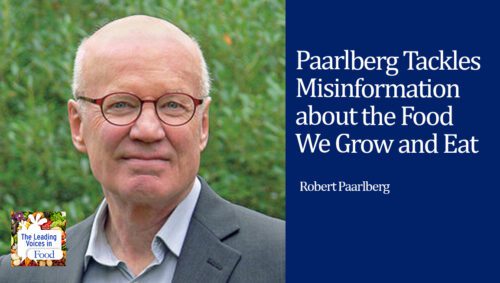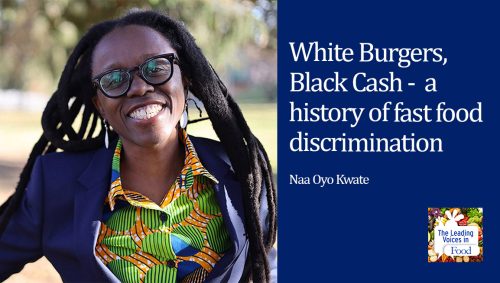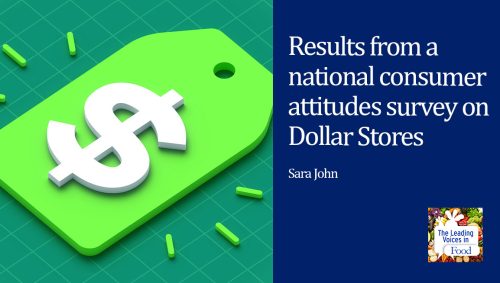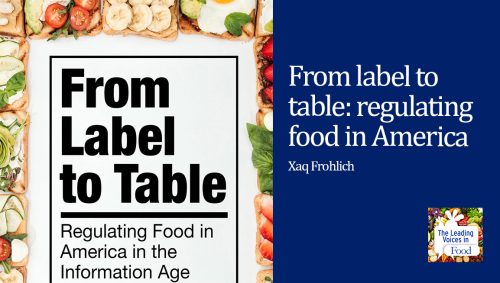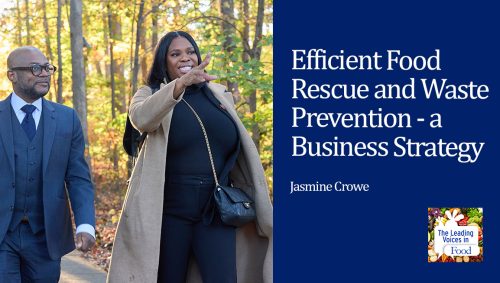The Leading Voices in Food
E155: How Industry and Farming Practices Contribute to Antibiotic Resistant Superbugs
Antibiotic resistance has long been considered one of the greatest threats to global health. More recently, we’re seeing growing public awareness around the overuse of antibiotics used in the US livestock system – a system that produces much of our meat supply. Widespread antibiotic use on US farms has evolved from something that only a small group of advocates and scientists worried about to something many more people are talking about now. The term antibiotic free is showing up on products and supermarkets and the way fast food chains are advertising their products. With drug resistant pathogens or superbugs, as some people know them, now being called the slower moving pandemic, it’s time to check in on both how the science and the policy are evolving in this important part of our food system. And there’s no one better than our guest to help deal with this. Dr. David Wallinga is senior health officer for the Food, Agriculture and Health, Healthy People & Thriving Communities Program at NRDC, the Natural Resources Defense Council, a leading environmental organization. David is a physician, and has led the way on connecting science with policy in the area of food and environment. He is highly regarded for his work on antibiotics and the food supply.
Subscribe: Apple Podcasts | TuneIN | Google Podcasts | SoundCloud | PocketCasts | Radio Public
Tags: Antibiotic Resistance | Food Industry Behavior & Marketing | Food Safety & Food Defense |

Dr. David Wallinga is a physician with more than 20 years of experience in writing, policy, and advocacy at the intersection of food, communities, and health. His work on food and farming as an ecologically-based system has laid the groundwork for understanding them as important social and environmental determinants of health. He has worked to address the impact of federal pesticide policies and practices on child brain health; to change Farm Bill policies that promote overproduction and overconsumption of junk food calories and have helped fuel a rise in obesity; and to reverse the enormous overuse of antibiotics in industrial-style U.S. livestock production, its contribution to a “slow-moving” pandemic of superbug bacteria, and the federal policies that incentivize these practices. Dr. Wallinga advocates for policies that promote production of good food for communities that is more accessible, safe, and nutritious; more resilient, climate-friendly livestock production that is also safer for downstream communities; and investments in food systems and rural communities based on equity and fairness. He completed his medical school education at the University of Minnesota. He also holds a bachelor’s degree in political science from Dartmouth College and a master’s degree in public affairs from Princeton University. He lives in St. Paul, Minnesota, but is descended from Iowans.
Interview Summary
So David, I recorded a podcast with you many years ago when I was at Yale University. We were discussing this important topic, and boy, a lot’s been discovered since then. So it’ll be nice to dig in and get updated. So again, thanks for being with us. I’ve really long admired your work and your passion and your ability to communicate what is pretty complex science in this area. So, David, how did the use of antibiotics in the food supply begin? What are the origins of the story?
Well, a book that came out in 2014 told a really compelling story that I’d never heard before (The Chain: Farm, Factory, and the Fate of our Food). And it seems to suggest that it started with the Hormel Company, the makers of SPAM, who were trying to keep up with demand for the SPAM product after world war II, and was having trouble. And one of the things they did was to reach out to researchers from the University of Minnesota to see if feeding antibiotics, these new miracle drugs, through animal feed to chickens and pigs could have an effect of them putting on weight faster, which they thought might be the case. And at least initially that did turn out to be true. So at Hormel Institute, this is what they called it, the collaboration between the researchers and the company continues today and is very involved with the University of Minnesota, as well as the Mayo clinic.
That’s so interesting that the story began with not only using antibiotics to prevent or help cure disease, but just to make the animals grow faster and produce more meat.
Well, they didn’t actually start off to prevent disease, that wasn’t mentioned anywhere, at least in Genoway’s account. The thought was not to use them to treat disease, but rather they reasoned that if they could use the antibiotics to kill off some of the gut bacteria, then the animals would be able to divert more energy into growing. So really, it was always designed from the get go to put on weight in animals that were otherwise healthy.
Oh, that’s so interesting. So, how widely used are antibiotics in the food supply?
Well, flash forward many decades, they’re extremely widely used globally and in the US. Globally researchers estimated 70% of all the medically important antibiotics – and by that, I mean, ones that are used in livestock as well as in people – so about 70% or more are used on farms, especially in livestock production. In the US it’s about the same amount, roughly two-thirds.
Oh, those are staggering numbers. So what are the up and downsides of this big use?
I see few upsides actually. People for time immemorial have been raising animals without antibiotics quite successfully. And there are still ways to raise them even at large scale, without antibiotics as we can get into later.
What about that assumption that the antibiotics produce more efficient meat production and make the animals grow faster, etc.?
I don’t really see much evidence for that. When you actually look at the efficiency, there have been some studies of what’s happened in Europe. They’ve really been very deliberate about reducing and eliminating antibiotic use that’s not needed. And what they found is you can do it for the most part, without affecting productivity. And you can do it without any impact on cost either or very little impact on cost, including to the consumer. And when you factor in the public health benefit of just avoiding antibiotic use in the first place, it really comes out as a win-win.
Well, that’s very important information. So what are the downsides?
Well, the downsides come from a couple of things. One is the vast majority of the antibiotics that are being used in livestock are put into their feed or in their drinking water. So that means you’re feeding them on a pretty regular basis to entire herds. And the equivalent would be, I suppose, mass dosing human beings, whether or not they needed antibiotics, because you thought that some of those people might need them. Like putting it in a drinking supply for a city. You’re just creating many more little breeding grounds for resistant bacteria. And that’s exactly what we’re doing on US livestock farms. We’re creating perfect storm conditions for breeding superbugs, and then spreading them throughout the farm environment. And ultimately in the worst case, to the human population as well.
And how dangerous are these?
Well, they’re really dangerous. We can’t separate the superbugs and farms easily from the superbugs and hospitals. And in many cases, they’re the same species of bacteria. We’re talking about salmonella and staphylococcus and E. coli and drug resistant strains of these are killing large numbers of people in hospitals and outside of hospitals. So the CDC periodically updates these numbers, but the last numbers we have are that every year there’s about 2.8 million or more drug resistant infections in the US and they contribute to at least 35,000 deaths a year, and maybe as many as 162,000 deaths a year in the US. Now, globally, if we don’t do a better job about using antibiotics smarter, there’s estimates that globally by the year 2050 there might be 10 million deaths a year. Ten million deaths, and trillions of dollars in costs.
Let me ask you this question. How do these bugs spread from the farms out there into the broader world? Is it through the food itself?
Well, for one thing, bugs, whether they’re viruses or bacteria, don’t really respect the same kind of boundaries between farms and hospitals and communities that we believe exist. The bugs travel pretty freely between them all. And so they get from animals to people in a variety of ways. First of all, as I said, the antibiotics are put into feed and the feed gets pooped out by the animal and ends up in the manure. So anywhere the manure goes, whether it’s manure dust blowing in the wind, manure runoff into streams, or people just handling the animals and then taking the traces of that manure home with them, all of those can spread drug residues, but also a resistant bacteria. The genes in the bacteria are what make them resistant. Those can travel in all those environments as well. Maybe the thing people worry most about is on food. And in fact, in the US and in other places too, we have programs that test raw meat and poultry looking for signs of resistance. And the bad news is that it’s fairly ubiquitous. Virtually anywhere we look, with a fair amount of frequency, we see evidence for resistance and resistant bacteria on those raw meats. Now, ideally, people would be using really good hygiene when they’re in the kitchen, handling those meats. They would be cooking the meat really well, but that’s not a failsafe. If it were, we wouldn’t be having millions of cases of food poisoning every year, but we do.
Pertinent to that, I just saw a news report today – and you may not have seen it yourself – and I’m just quoting from it. It said that a gene that causes bacteria to be resistant to the one of the world’s most important antibiotics, Colistin, has been detected in sewer water in Georgia. What do you make of that?
I say it’s not at all surprising. Colistin is what we call a drug of last resort. We’ve been using up a limited supply of these miracle antibiotics for decades. It’s very hard to come up with new ones. We’re not investing in making new ones, and I’m not even sure we can make new ones. So we have to keep the old ones safe for as long as possible. But more and more, the bacteria are resistant to a lot of the older antibiotics like penicillins and tetracyclines. So we’ve got a few of the newer ones, namely Colistin, and some what are called next generation cephalosporins and fluoroquinolones. But those two are spurring resistant. And now we have examples of superbugs that are basically resistant to everything, they’re untreatable. Now, thankfully, those are pretty far and few between for now. But we can see the writing on the wall. And when those start to break out and multiply, we’re going to have a lot bigger increases in deaths and cases.
Well, it’s a pretty scary picture. So let’s talk about how things are changing. Is my perception that consumers are growing more aware of this issue accurate, and is this affecting corporate practices?
Yeah, it’s accurate. I’ve been working on this exact issue for over 20 years. When we started public awareness, we did polling, public awareness was very low. For one thing, science literacy is not what it should be in general. People just have a lot of misconceptions about what drug resistance is. There’s a common misconception that people are resistant to the drugs, and that’s not the case. So what we’re talking about is not eating foods contaminated with the drugs themselves, we’re talking about using these drugs too much, whether in human medicine or on farms, and creating the conditions that make drug resistant bacteria multiply. And they multiply very, very quickly and then spread. And as a result, our farm environments, our streams, our sewage, as you said, and our meat and food supply are all contaminated now with drug resistant bacteria. And they’re spreading, and that’s the problem. And people are getting aware of it because like COVID, eventually more and more people have loved ones who are getting sick with hard to treat infections or even dying.
So, tell me how corporations are responding to this public awareness. It is changing things in the food supply chain by let’s say fast food restaurants or big food sellers?
Well, groups like NRDC and our partner groups, we’ve been advocating for quite a while now to some of the countries and the world’s biggest fast food chains, restaurant chains, and the like, to do a couple of things. One, make commitments to use fewer antibiotics in their supply chains. We know it’s possible. We can get into how we know that later, but we know it’s possible. And those are the biggest purchasers of those meat and poultry suppliers. So presumably if they ask their vendors to sell them product that’s produced with fewer antibiotics, some of the vendors will find a way to do it. That whole strategies worked pretty well for chicken production, for example. In part companies like Tyson and Purdue got out early and discovered that in fact, they could raise broiler chickens almost without any antibiotics at all, it turns out. And so now, well above 90% of the chicken produced today in the US is produced with no antibiotics at all, or very few antibiotics. And you had mentioned at the top of the podcast, seeing labels like antibiotic free at the supermarket, that’s mainly on chicken. It turns out it’s been really much, much harder to see any kind of leadership by companies in pork or beef production. And the fast food chains too, have been really slow by and large too. And with just a few exceptions to commit to buying and serving pork or beef raised without routine antibiotics. Now, the exceptions are places like Chipotle, for example, or some of the smaller chains. But if you’re talking about big places like Wendy’s, McDonald’s, Burger King, they really have been slow to make any forward progress at finding ways to reduce antibiotic use in their supply chains.
So such significant changes occurred in the chicken sector, why not in beef and pork?
Well, there’s practical reasons with a big caveat. The practical reason is that a modern chicken only lives for six weeks. So all you’ve got to do is create conditions where you can get those fast-growing birds from the egg to the chicken, then from the chick to the slaughterhouse in just six weeks. So that makes it a little bit easier to control conditions for that long. Pigs and cows live a lot longer. The time to slaughter for a mature hog is about six months. The time to slaughter for a cow that goes from a calf stage then goes to a feed lot and gets fattened up, about a year and a half, maybe longer, maybe shorter, but it’s a lot longer than a chicken. Now, with that said, have other countries found ways to produce chickens and cows with no or very few antibiotics? Well, yes, they have. Even pretty industrial producers of pork like Denmark and the Netherlands are using these medically important drugs at a rate that’s one fifth, one sixth, one seventh, as much as what the US uses. So let me just repeat that. The US pig and pork industry has seemed to be using four or five, six or more times as many antibiotics on a milligram per kilogram basis as do their counterpart industries in other countries.
So this is a good segue to ask about the role of government in that picture in your mind.
Yeah, good question. The role of government is one, to protect the public. And here it’s good to go back to basics. When it comes to superbugs and the spread of resistance, we know what the biggest problem is. The biggest problem is using antibiotics, and especially overusing antibiotics. And that doesn’t matter if we’re talking about the clinic or the hospital or the farm. Wherever you’re overusing drugs when you don’t need to, you’re helping create the spread of resistance. And so that job number one for government should be to track the problem, to find ways to reduce antibiotics, to avoid using antibiotics, and also we argue, to set targets. And then if you’ve got a program in place to track the use of antibiotics, you’ll be able to tell whether you’re meeting your target or not. Now, sadly, the US doesn’t do any of those things. Much of Europe is doing all of those things, and quite successfully. And so one of the things we’re doing at NRDC with partners is we’re jumping into the failure of the US agencies to protect the public. And we’re doing their work for them. We’re tracking antibiotic use on farms and the way that Europe does. And then we’re comparing the overuse in US farms to much, much lower levels of use across much, if not all of Europe.

